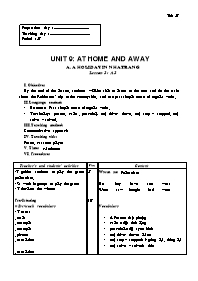Giáo án môn Tiếng Anh Lớp 7 - Unit 9: At home and away - A. A holiday in nha trang - Lesson 3: A3

I. Objective:
By the end of the lesson, students will be able to listen to the text and do the tasks about the Robinsons’ trip to the countryside, and use past simple tense of regular verbs.
II. Language content:
- Grammar: Past simple tense of regular verbs.
- Vocabulary: peanut, calm , peaceful, (to) drive- drove, (to) stop – stopped, (to) arrive – arrived.
III. Teaching method:
Communicative approach
IV. Teaching aids:
Poster, cassette player
V. Time: 45 minutes
Bạn đang xem tài liệu "Giáo án môn Tiếng Anh Lớp 7 - Unit 9: At home and away - A. A holiday in nha trang - Lesson 3: A3", để tải tài liệu gốc về máy bạn click vào nút DOWNLOAD ở trên
- Preparation day : - Teaching day : - Period : 57 UNIT 9: AT HOME AND AWAY A. A HOLIDAY IN NHA TRANG Lesson 3: A 3 I. Objective: By the end of the lesson, students will be able to listen to the text and do the tasks about the Robinsons’ trip to the countryside, and use past simple tense of regular verbs. II. Language content: Grammar: Past simple tense of regular verbs. Vocabulary: peanut, calm , peaceful, (to) drive- drove, (to) stop – stopped, (to) arrive – arrived. III. Teaching method: Communicative approach IV. Teaching aids: Poster, cassette player V. Time: 45 minutes VI. Procedure: Teacher’s and students’ activities Time Content -T guides students to play the game pelmanism. - Ss work in groups to play the game - T declares the winner Pre-listening + Pre-teach vocabulary - T uses: . realia . example . example . picture . translation . translation Ss listen, repeat and copy T checks : ROR + Pre-listening activity - T sets the scene: “ You are going to listen to the text about The Robinsons’ trip to the countryside.” - Ss listen to the situation - T asks students to read and guess the sentences they will hear. - Ss read and guess the sentences they will hear then say their guesses. - T writes their guesses on the board. While listening - T turns on the cassette twice. - Ss listen and check their guesses then give the answers. - T gives feedback from the tape. - T asks students to listen to the tape and complete the passage. - Ss listen to the tape twice to complete the passage and then give the answers. T gives feedback from the tape. + Presentation the target language: - T elicits the model sentence from the listening text. - Ss say the model sentence. - T writes the model sentence on the board and checks the form, the use, the meaning and the pronunciation. Ss copy Post listening - T guides students to interview Liz about her family’s trip back to Ha Noi. - Ss work in pairs to practice speaking. - T controls the activity. 5’ 10’ 20’ 10’ Warm up: Pelmanism Go buy have see wear Wore saw bought had went Vocabulary A Peanut: ñaäu phoäng calm (adj): tónh laëng peaceful (adj) : yeân bình (to) drive- drove: laùi xe (to) stop – stopped: Ngöøng laïi , döøng laïi (to) arrive – arrived: ñeán Prediction Listen. Write the letter of the sentences you hear. a) The Robinsons returned to Ha Noi by train. b) The Robinsons returned to Ha Noi by bus. c) This was the second time Liz saw the paddies. d) This was the first time Liz saw the paddies. e) They stopped at the restaurant for a short time. f) They stopped at the restaurant for a long time. g) Mr.Robinson bought some food for Liz. h) Mrs. Robinson bought some food for Liz. i) They arrived home in the afternoon. j) They arrived home in the evening. Answer key b – d – e – h – j Gap – fill Listen and complete the following paragraph Liz was excited as the bus (1) _______ through the countryside. Everything (2) _____ calm and peaceful. At 4 o’clock the bus (3) _____ at a small roadside restaurant. Mrs. Robinson (4) _____ some peanuts and an ice-cream for Liz. The bus (5) ____ in Ha Noi at about 7 pm. Answer key Listen and complete the following paragraph Liz was excited as the bus drove through the countryside. Everything was calm and peaceful. At 4 o’clock the bus stopped at a small roadside restaurant. Mrs. Robinson bought some peanuts and an ice-cream for Liz. The bus arrived in Ha Noi at about 7 pm. Model sentences: The Robinsons returned to Ha Noi by bus. Notes: Past simple tense of regular verbs S + V- ed Negative form: S + did not + V1 did not = didn’t Interrogative form: Did + S + V1? Yes, S + did No, S + didn’t Caùch theâm “- ed” Stop à stopped Arrived à arrived Try à tried Caùch ñoïc ñuoâi “ – ed” Coù 3 caùch ñoïc ñuoâi “ – ed” 1. Ñoïc laø / id/ : khi nhöõng ñoäng töø taän cuøng phaùt ra aâm / t / vaø / d / à wanted , decided 2. Ñoïc laø /t/ : khi nhöõng ñoäng töø taän cuøng phaùt ra aâm voâ thanh: /p/, / tS/ , / k/ , /f /, /s/, /S/ à looked, watched, stopped 3. Ñoïc laø /d/ : nhöõng tröôøng hôïp coøn laïi à returned , tried , Role play 1. How did you travel back to Ha Noi? 2. What did you see on the way back ? 3. How did everything look? 4. Were you tired ? 5. When did you arrive in Ha Noi ? Homework - Learn new words and structure. - Prepare unit 9 : A 4
Tài liệu đính kèm:
 giao_an_mon_tieng_anh_lop_7_unit_9_at_home_and_away_a_a_holi.doc
giao_an_mon_tieng_anh_lop_7_unit_9_at_home_and_away_a_a_holi.doc





